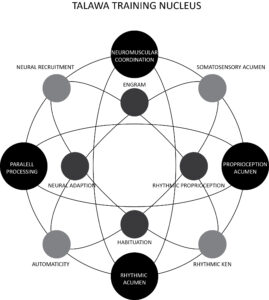
Description of the NUCLEUS Illustration
In this illustration, the twelve key aspects of the Talawa Technique™ are depicted within a nucleus-like structure. This model emphasizes the interconnectedness and dynamic interplay of these concepts, much like particles in an atomic nucleus. The structure consists of four primary “protons” situated at the cardinal points, representing the core pillars of the Talawa Technique™. These are complemented by intermediate “neutrons” that fill the spaces between the protons, and an inner circle of additional neutrons, highlighting the foundational processes that support and enhance the primary skills.
Four Largest Protons:
- Neuromuscular Coordination (North): This is the harmonious interaction between the nervous and muscular systems, essential for smooth and efficient movement. In Talawa Technique™, it ensures precise control over complex sequences.
- Proprioception Acumen (East): This skill involves a refined ability to sense and control the body’s position and movement, enhancing balance, spatial orientation, and coordination, crucial for executing intricate movements.
- Parallel Processing (West): This cognitive ability allows the brain to manage multiple streams of information simultaneously, vital for integrating various rhythmic and movement patterns in Talawa Technique™.
- Rhythmic Acumen (South): This is the ability to perceive, understand, and interpret rhythmic patterns, enabling dancers to navigate and express the intricate polyrhythmic structures of Talawa Technique™.
Intermediate Neutrons:
- Somatosensory Acumen (Between Neuromuscular Coordination and Proprioception Acumen): This involves the perception and interpretation of sensory information from the body, allowing dancers to adjust their movements based on sensory feedback.
- Rhythmic Ken (Between Proprioception Acumen and Rhythmic Acumen): Rhythmic Ken, or rhythmic knowledge, encompasses both theoretical and practical understanding of rhythmic structures, enabling innovation within the Talawa Technique™.
- Automaticity (Between Rhythmic Acumen and Parallel Processing): Automaticity is the ability to perform tasks without conscious thought due to extensive practice, allowing dancers to focus on expression and improvisation.
- Neural Recruitment (Between Parallel Processing and Neuromuscular Coordination): This is the process by which the nervous system activates specific motor units within muscles, essential for executing movements that require varying degrees of force and precision.
Inner Circle Neutrons:
- Engram (North Inner Circle): An engram represents a physical trace of memory in the brain, encoding specific motor patterns through repeated practice, making complex movements more automatic and refined over time.
- Habituation (South Inner Circle): This process allows dancers to become accustomed to repeated stimuli, enabling sustained, repetitive sequences with reduced mental effort and increased endurance.
- Rhythmic Proprioception (East Inner Circle): Involves awareness of the body’s position and movement in relation to rhythm and music, crucial for synchronizing movements with complex rhythmic patterns in Talawa Technique™.
- Neural Adaptation (West Inner Circle): This refers to changes in the nervous system in response to repeated stimuli or practice, enhancing the efficiency and speed of neural processing for improved performance.
Integration and Contextualization within the Talawa Technique™
The illustration visually represents the integration of these twelve aspects within the Talawa Technique™. The primary protons—Neuromuscular Coordination, Proprioception Acumen, Parallel Processing, and Rhythmic Acumen—serve as the foundational pillars. These core elements are crucial for the execution of the technique’s complex, polycentric, and polyrhythmic movements.
The intermediate neutrons (Somatosensory Acumen, Rhythmic Ken, Automaticity, and Neural Recruitment) fill the spaces between these pillars, indicating their supportive role in enhancing and refining the primary skills. For example, Somatosensory Acumen between Neuromuscular Coordination and Proprioception Acumen highlights its role in sensory feedback for movement precision.
The inner circle of neutrons (Engram, Habituation, Rhythmic Proprioception, and Neural Adaptation) signifies the foundational processes that solidify and refine the dancers’ abilities. These processes contribute to the development, retention, and enhancement of skills, ensuring that dancers can perform with technical precision and expressive freedom.
This holistic approach to training, as visualized in the nucleus illustration, highlights the complexity and depth of the Talawa Technique™. It underscores the importance of each aspect, showing how they collectively contribute to a dancer’s mastery of the polycentric and polyrhythmic movements that define this unique and innovative dance form. The Talawa Technique™ leverages this integrated framework to develop dancers who are not only technically proficient but also deeply attuned to the expressive and rhythmic nuances of their movements, setting it apart as a powerful and transformative method in the world of dance.
